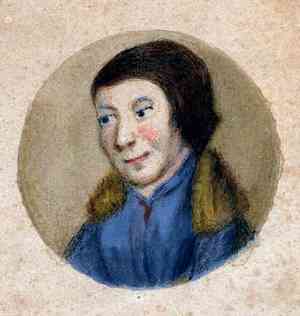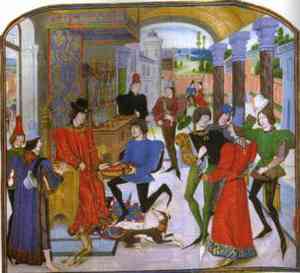


Gilles Binchois
Pleased with himself while making people cry
Source: Wikipedia

Burgundian Court of Philip the Good
Frontispiece to Chroniques de Hainaut
Possibly by Rogier van der Weyden no later than 1452
Source: SUNY OneontaBorn about 1400 in Netherlands (Low Countries), Gilles Binchois (Gilles de Binch) was a composer of the Burgundian School in France, wellspring of the early musical Renaissance. He was perhaps a few years younger than his close associate, Guillaume Dufay, principle stylist of the Burgundian School which was the early phase of the greater Franco-Flemish School emerging about 1420 to supply music to Europe throughout the Renaissance. The Proto-Renaissance had emerged in Italian art in the latter 13th century (exemplar in Giotto), beginning what is called the "long" Renaissance of 1300-1600 with the French Renaissance arriving in the latter 14th century. The Early Renaissance covers the years 1425 to 1495, Botticelli's 'Birth of Venus' painted c 1482-86. The High Renaissance of 1495 to 1520 wrought such as Michelangelo's 'Pietà' in 1498–99 and Leonardo da Vinci's 'Mona Lisa' c 1503-07. Mannerism is the Renaissance extended to 1600. Though the Renaissance in art and architecture was for the greater part an Italian spectacle, in music it was a largely Franco-Flemish affair.
By the time of Binchois' birth the French House of Plantagenet across the Channel in England had become the British House of Lancaster, to remain so throughout Binchois' life (House of York 1471, Tudor 1485). It was during Binchois' lifetime that Pope Nicholas V began to build the Vatican Library with ancient Greek and Latin texts in 1447. Binchois would be alive when the Muslim Ottoman Empire removed Eastern Orthodoxy from Constantinople, the latter falling in 1453 to become Istanbul.
Between the two friends that were DuFay and Binchois, DuFay has received greater scholarly attention and was probably the more popular at the time. One way, however, in which Binchois distinguished himself was in his beautiful expressions of dolor. Binchois couldn't have been happier than to make somebody weep. The majority of Binchois' secular chansons (songs) were rondeaux concerning chivalry and love, he also writing ballades (stories). Of his nigh 60 extant songs, 46 of them are rondeaux. "R" numbers herein cited are from 'Die Chansons von Gilles Binchois' edited by Wolfgang Rehm published in Mainz by Schott in 1957. Numbers in Rehm follow a somewhat alphabetical of incipits rather than chronological scheme. Though Binchois had no university degree, thus could not have been a priest, he also composed a great amount of sacred music including Kyries, Glorias, Creedos, Sancti and Magnificats. "K" numbers cited herein are from 'The Sacred Music of Gilles Binchois' by Philip Kaye published by Oxford University Press in 1992.
Records find Binchois' earliest activity to be that of a church organist at Sainte-Waudru in Mons in 1419. Michael W. Beauvois posits in 'Towards a Chronology of the Chansons of Gilles Binchois' that 'Je me recommande' is his earliest composition dating from that year. IMSLP shows a much later date of c 1448 for 'Je me recommande humblement' estimated from the Codex Trent 87 begun in 1445. 'Je me recommande' was also copied into MS. Canon. Misc. 213 begun about 1430 in Venice, and the later 'Seville Chansonnier' of circa 1885. Eduard Botanch Albó at Figures Singulars distinguishes a 1448 version as 'M’encomano humilment'. 'Je me recommande' is assigned R. 18 per Rehm, but I've not been able to match that to a date.
Compositions by Binchois were copied into numerous early codices, such as Hermann Pötzlinger's collection titled 'Sankt Emmeram' which he might have begun as early as 1439 in Vienna. Binchois is included in the Aosta Manuscript begun sometime after 1440. Songs from his middle period appeared in the Codex Escorial Chansonnier MS V III 24 which part (V) had been collected 1460-1474. The Escorial had been begun in 1430.
About 1423 Binchois is thought to have signed on as a soldier in the cause of William de la Pole, Earl of Suffolk, that an involved page out of the greater Hundred Years War of 1337 to 1553, during which messy period English kings vied with French over the throne of France. A document of 1427 has William (to become First Duke of Suffolk in 1448) commissioning Binchois with the rondeau, 'Ainsi que a la foiz m'y souvient', in 1424, for two rolls of red cloth. By 1427 Binchois had joined the court chapel of Burgundy to become a singer among eighteen others there vocally employed. Along with the Duchy of Aquitaine, the Duchy of Burgundy had been allied with the English against the Dukes of Orleans powering the French claim to throne.
The earliest composition known to have been written by Binchois for Philip the Good, being Philip III, Duke of Burgundy, was 'Nave Cantum Melodie' for the occasion of the baptism of Philip's son, Antoine, on 18 January 1431. Anthony was Philip's first son and lived only a year and a half from 30 September 1430 to 5 February of 1432. Philip's second son, Josse, lived only a few weeks during 1432. Charles the Bold arrived in 1433 and became Duke of Burgundy from Philip's death in 1467 to 1477. As for 'Nave Cantum Melodie', that is Binchois' only motet in isorhythmic ("same rhythm") form, in comparison to which DuFay wrote not a few. Despite Binchois' oeuvre in sacred music, he is generally hailed for his rondeaux, probably writing his final in 1452 per 'Comme femme desconfortee' [Beauvois]. Due to the difficulty of dating Binchois, titles below are stacked per Rehm number without regard to chronological order. All are rondeaux for three voices, excepting one representative ballade, which are settings to texts by anonymous authors (to me at least) but for one linked to Alain Chartier (c 1385-1430).
'Adieu, adieu, mon joileux souvenir' Rondeau by Gilles Binchois (Rehm 1)
'Farewell My Happy Memory'
Lena Susanne Norin w Randall Cook & Susanne Ansorg
'Je me recommande humblement' Rondeau by Gilles Binchois (Rehm 18)
'I Humbly Recommend Myself'
TENET Vocal Artists Tenor: Jason McStoots St. Peter’s Church NYC 2016
'Les tres doulx yeux du viaire ma dame' Rondeau by Gilles Binchois (Rehm 24)
'The Sweetest Eyes of My True Lady'
Ensemble Graindelavoix / Björn Schmelzer
'Triste plaisir et douleureuse joye' Rondeau by Gilles Binchois (Rehm 45)
'Sad Pleasure and Painful Joy' Text by Alain Chartier
Lena Susanne Norin w Randall Cook & Susanne Ansorg
'Vostre tres doulx regart' Rondeau by Gilles Binchois (Rehm 47)
'Your Very Sweet Glance'
Ensemble Gilles Binchois / Dominique Vellard
'Amours merchi de trestout mon pooir' Ballade by Gilles Binchois (Rehm 49)
'I Thank Love with All My Strength'
Ensemble Gilles Binchois / Dominique Vellard
'Comme femme desconfortee' Rondeaux by Gilles Binchois (Rehm 56)
'As a Woman Discomforted'
The Binchois Consort directed by Andrew Kirkman
Touching on the sacred in Binchois just a little, his 'Gloria laus et honor', found in the Trent 87, is a motet cycle in two parts being 'Gloria laus et honor' (1a) and 'Israel es tu rex' (1b). Binchois also availed himself of DuFay's faux bourdon (false drone) method of styling cantus firmus plainchant melodies with another part a sixth interval below and a third a perfect fourth. DuFay had first developed that form in 1433 ('Supremum est mortalibus').
'Gloria, laus et honor' Hymn for 3 voices by Gilles Binchois (Kaye 39)
'Glory, Praise and Honor'
Ensemble Gilles Binchois / Dominique Vellard
'Veni creator spiritus' Plainchant in faux bourdon setting by Gilles Binchois (Kaye 51)
'Come, Creator Spirit'
Ryusuke
In 1452 Binchois retired from his career of persuading women to be sad at the court of Burgundy to a position as provost at St. Vincent in Soignies until his death on 20 September 1460. The construction of St. Vincent had begun circa 1020 in magnification of a church dedicated to St. Vincent that had been built there upon his death on 14 September 677. It took a couple centuries to arrive to its greater structure.

Collégiale St. Vincent de Soignes
Source:
FindaGrave
The Burgundian School flourished under the auspices of Philip the Good until his death on 15 June 1467. DuFay outlived both Binchois and Philip until 27 November 1474.
Sources & References for Gilles Binchois:
Eduard Botanch Albó (Figures Singulars 500-1500)
J. Michael Allsen (Medieval France: An Encyclopedia / Ed. Kibler / Zinn 1995/2011)
Joan A. Boucher (The Religious Music of Gilles Binchois / Boston University 1963)
Timothy Dickey (All Music)
Helen Marshall Gibbons (A Collection of Solo French Chansons / Louisiana State University 1986)
Franklin Paul Halpin (Study of the Burgundian Chanson / University of Montana 1968)
Andrew Kirkman / Dennis Slavin (Binchois Studies / Oxford University Press 2000)
Dennis Shrock (Choral Repertoire / Oxford U Press 2009)
Philippe Vendrix / David Fiala (Musique, pouvoir et légitimation aux xve et xvie siècles)
VF History (notes)
Jean-Marc Warszawski (Musicologie)
Wikipedia
(English)
Wikipedia (German)
Audio of Gilles Binchois:
Classical Archives
The Burgundian School:
Compositions: Chronology: Michael W. Beauvois
Compositions: Corpus w Scores:
Compositions: Individual (mentioned herein):
Adieu, adieu, mon joileux souvenir (Rehm 1):
Robert Jan Dukarm M. Parks (MUSC520 Musical Styles)
Amours merchi de trestout mon pooir (Rehm 49): Donato Mancini
Comme femme desconfortee (Rehm 56): Peter Woetmann Christoffersen
Gloria, laus et honor (Kaye 39): John Keillor
Veni creator spiritus (Kaye 51): Wikipedia
Franco-Flemish School: Wikipedia
Lyrics / Texts: LiederNet
Amours merchi de trestout mon poir (Rehm 49)
Comme femme desconfortee (Rehm 56)
Les tres doulx yeux du viaire ma dame (Rehm 24)
Triste plaisir et douleureuse joye (Rehm 45)
MSS (manuscript collections containing Binchois):
Mensural Codex of Saint Emmeram
Recordings: Catalogs:
Discogs HOASM Medieval Music Brainz Presto RYM
Scores: Je me recommande (Rehm 18)
Further Reading:
Gilles Binchois:
Dennis Slavin (Questions of Authority in Some Songs by Binchois / Journal of the Royal Musical Association / 1992)
Codices:
Margaret Bent (Trent 92 / Aosta)
David Fallows (MS. Canon. Misc. 213)
Dr. Hugo Reimann (Mus. MS. 3192)
The Renaissance:
Spain: Smart History Wikipedia
Bibliography:
David Fallows (Review of Philip Kaye's The Sacred Music of Gilles Binchois / 1993)
Hermann Pötzlinger (The St. Emmeram Codex and its Contexts / 1439 >)
Wolfgang Rehm (Die Chansons von Gilles Binchois / Schott 1957)
Rob C. Wegman (Review of Walter Kemp's Burgundian Court Song in the Time of Binchois: The Anonymous Chansons of El Escorial MS V. III. 24)
Sources & References for Classical Music:
Composers Works Directories & Thematic Catalogs: ClassicalNet
Classical Main Menu Modern Recording
|
|
hmrproject (at) aol (dot) com